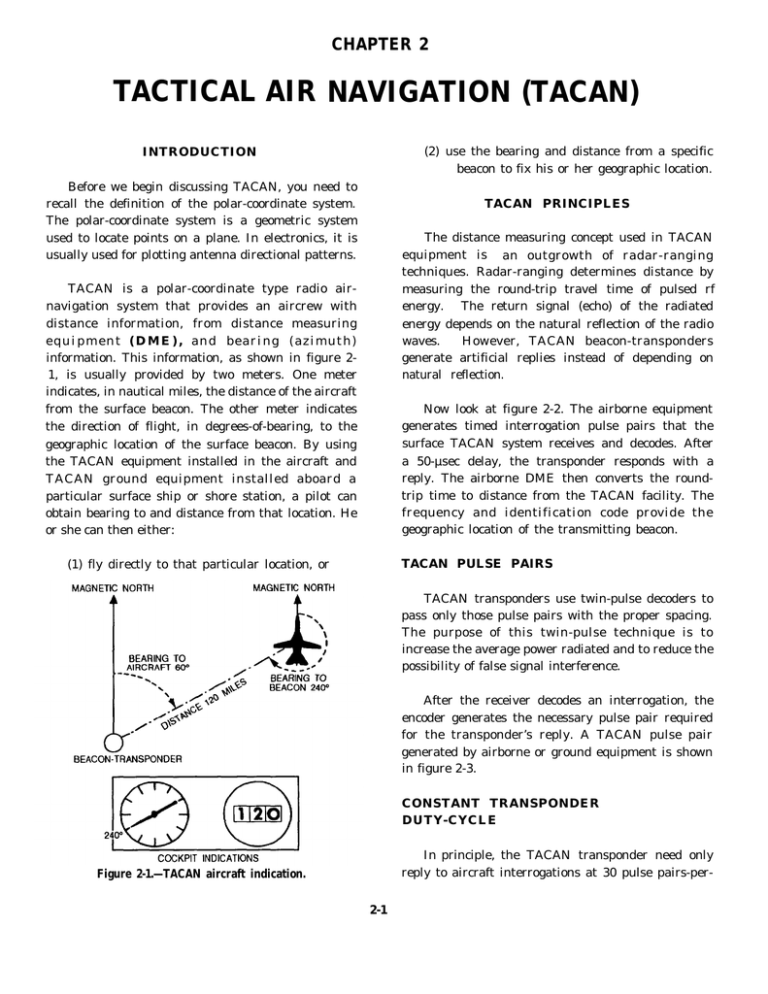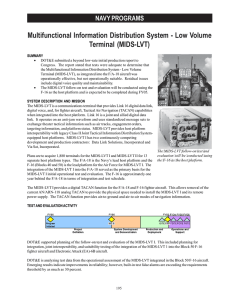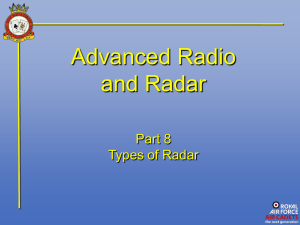TACAN: Tactical Air Navigation Principles & Equipment
advertisement

CHAPTER 2 TACTICAL AIR NAVIGATION (TACAN) (2) use the bearing and distance from a specific beacon to fix his or her geographic location. INTRODUCTION Before we begin discussing TACAN, you need to recall the definition of the polar-coordinate system. The polar-coordinate system is a geometric system used to locate points on a plane. In electronics, it is usually used for plotting antenna directional patterns. TACAN PRINCIPLES The distance measuring concept used in TACAN equipment is an outgrowth of radar-ranging techniques. Radar-ranging determines distance by measuring the round-trip travel time of pulsed rf energy. The return signal (echo) of the radiated energy depends on the natural reflection of the radio waves. However, TACAN beacon-transponders generate artificial replies instead of depending on natural reflection. TACAN is a polar-coordinate type radio airnavigation system that provides an aircrew with distance information, from distance measuring equipment (DME), and bearing (azimuth) information. This information, as shown in figure 21, is usually provided by two meters. One meter indicates, in nautical miles, the distance of the aircraft from the surface beacon. The other meter indicates the direction of flight, in degrees-of-bearing, to the geographic location of the surface beacon. By using the TACAN equipment installed in the aircraft and TACAN ground equipment installed aboard a particular surface ship or shore station, a pilot can obtain bearing to and distance from that location. He or she can then either: Now look at figure 2-2. The airborne equipment generates timed interrogation pulse pairs that the surface TACAN system receives and decodes. After a 50-µsec delay, the transponder responds with a reply. The airborne DME then converts the roundtrip time to distance from the TACAN facility. The frequency and identification code provide the geographic location of the transmitting beacon. TACAN PULSE PAIRS (1) fly directly to that particular location, or TACAN transponders use twin-pulse decoders to pass only those pulse pairs with the proper spacing. The purpose of this twin-pulse technique is to increase the average power radiated and to reduce the possibility of false signal interference. After the receiver decodes an interrogation, the encoder generates the necessary pulse pair required for the transponder’s reply. A TACAN pulse pair generated by airborne or ground equipment is shown in figure 2-3. CONSTANT TRANSPONDER DUTY-CYCLE In principle, the TACAN transponder need only reply to aircraft interrogations at 30 pulse pairs-per- Figure 2-1.—TACAN aircraft indication. 2-1 Figure 2-2.—Distance measuring round-trip travel time. If few transmitter, as shown in figure 2-4. interrogations are being received, the gain and squitter of the receiver increase and add noise-generated pulses to the pulse train. If more interrogating aircraft come into range, the gain and squitter decrease and reduce the number of noise-generated pulses. second, per airborne equipment, to supply the necessary distance data. However, the total pulse out put of the transmitter constantly varies, according to the number of interrogating aircraft. In addition, random noise may trigger the transmitter. The relationship between the gain and the number of pulses is such that only a 2-dBm change in sensitivity occurs between reception from 1 aircraft and those from 100 aircraft. An added advantage of using a constant duty cycle is that overall transmitter power drain remains constant. BEACON-TRANSPONDER IDENTIFICATION CODE Before an aircrew can use TACAN information that its equipment receives, it must positively identify the transmitting TACAN station. To meet this need, the ground station transmits an identification code at approximately one-half minute intervals. It does this by momentarily interrupting the transponder distance data and squitter-generated output with pulse groups spaced at a 1350-pps rate. Each pulse group contains two sets of 12-µsec pulse pairs spaced 100 µsec apart. The duration of the identification pulse groups varies, to represent Morse-coded characters. The duration for a dot is 100 to 125 ms, and for a dash 300 to 375 ms. An identification group is shown in figure 2-4. Figure 2-3.—TACAN pulse train. For the transponder to provide azimuth information, the average power supplied to the antenna must be relatively uniform over time. To accomplish this, the transponder is operated on the constant-duty-cycle principle. In this method of operation, the receiver uses automatic gain and squitter (noise generated output) controls to maintain a constant pulse output to the 2-2 Figure 2-4.—Transponder output pulse train. 15-HZ-BEARING INFORMATION The rf energy from the TACAN transmitter is fed to the antenna central element, which has no directivity in the horizontal plane. Parasitic elements are positioned around the central element electronically rotated (switched on and off) at 15 revolutions per minute. (See the section below on the OE-273(V)/URN antenna group). The distance between the central element and the parasitic elements is selected to obtain a cardioid radiation pattern. To an aircraft at a specific location, the distance data pulses appear to contain a 15-Hz amplitude-modulated signal because of the rotation of the cardioid radiation pattern. This pattern is shown in figure 2-5, view A and view B. The timing of the transmitted pulses supplies the actual distance information to the aircraft. This leaves amplitude modulation as another medium for the transponder to convey other information to the aircraft. The TACAN beacon-transponder modulates the strength of the pulse to convey bearing information by producing a specific directional-radiating pattern rotated around a vertical axis. This signal, when properly referenced, indicates the aircraft’s direction from the TACAN facility. This signal and distance data give a two-piece fix (distance and direction) for determining specific aircraft location. 2-3 section on the OE-273(V)/URN antenna group). Electronically switching these elements modifies the antenna cardioid pattern. Though the cardioid pattern is still predominant, it is altered by superimposed ripples. The aircraft now receives the 15-Hz signal with a 135-Hz ripple amplitude modulated on the distance data pulses (figure 2-6). To furnish a suitable reference for measuring the phase of the 135-Hz component of the envelope wave, the transponder is designed to transmit a coded 135Hz reference burst similar to that explained for the 15Hz reference. The 135-Hz reference group is commonly referred to as the auxiliary or aux reference burst. The composite TACAN signal is composed of 2700 interrogation replies and noise pulse pairs-per-second, plus 180 North burst pulse pairs-per-second, 720 auxiliary burst pulse pairs-persecond, for a total of 3600 pulse pairs-per-second, or 7200 pulses-per-second. TACAN SIGNAL PRIORITIES Figure 2-5.—TACAN radiation pattern: A. cardioid pattern; B. Ampltitude-modulated pulse pairs. Priorities have been established for transmission of the various types of TACAN signals. These priorities are as follows: The aircraft TACAN equipment obtains bearing information by comparing the 15-Hz modulated signal with a 15-Hz reference burst signal it receives from the ground facility. The phase relationship between the 15-Hz modulated signal and the 15-Hz reference burst signal depends on the location of the aircraft in the cardioid pattern. The 15-Hz reference burst signals are transmitted when the maximum signal of the cardioid pattern aims due East. This group of 12 pulse pairs is commonly referred to as the North or main reference burst. You can see the relationship between the reference pulses and the cardioid pattern by comparing view A and view B of figure 2-5. 1. Reference bursts (North and auxiliary) 2. Identification group 3. Replies to interrogations 4. Squitter Therefore, the identification group, replies, or squitter will be momentarily interrupted for the transmission of either the main or auxiliary reference group. The transmission of replies or squitter will be interrupted every 37.5 seconds during the transmission of an identification code dot or dash. 135-HZ BEARING INFORMATION Errors arising from imperfections in the phase CHARACTERISTICS OF RADIO BEACON SIGNALS measuring circuits and radio propagation effects are known as site error. These errors are significantly reduced by the addition of 32 outer parasitic elements added to the electronically scanned antenna. (See the Depending on what channel (X or Y) the TACAN is on, the number of pulses-per-second and the pulse 2-4 Figure 2-6.—TACAN modulation envelope spacing are a characteristic of that particular TACAN signal element. However, it is important to understand that proper spacing between pulses and pulse pairs is what actually provides the aircraft with the means to distinguish between the TACAN pulses and any other pulses that might be present on the received radio frequency. Check the reference data in the appropriate technical manual for specific pulse characteristics and spacing. operation, we will discuss only the OE-273/URN. In the following paragraphs, we will discuss the AN/URN-25 and the antenna group 0E-273(V)/URN, and then we will briefly discuss the AN/URN-20. TACAN SET AN/URN-25 The AN/URN-25 TACAN is used as a groundbased or shipborne beacon transponder to provide range and bearing information to aircraft equipped with TACAN equipment. It consists of two major units: the Transponder Group OX-52/URN-25, commonly referred to as unit 1, and the ControlIndicator C-10363/URN-25, commonly referred to as unit 2. These units are shown in figure 2-7. Each transponder is housed in a cabinet with two vertical drawers, one containing a coder keyer and the other containing a receiver-transmitter. TACAN EQUIPMENT Many different types of TACAN equipment have been used for air navigation. Today, the AN/URN-25 is taking over the task of tactical air navigation from the older AN/URN-20 on new construction ships and as ships complete overhaul. Two types of antennas are used with the AN/URN-25. They are the OE273(V)/URN, used primarily in shipboard installations, and the OE-258/URN, which is used primarily ashore. Because both antenna systems are similar in theory of The control-indicator displays the status of the transponder(s) and failure alarms, and allows limited control of the transponder(s) from a remote location. 2-5 2-6 parasitic elements arranged in concentric arrays around the central radiator. Twelve inner elements provide the 15-Hz modulation (replacing the singlephase rotating parasitic element in the mechanically rotated antenna), and 32 outer elements provide the 135-Hz modulation (replacing the nine outer elements The 15- and 135-Hz of the rotated antenna). modulation pattern is provided by electronically switching the diodes in each of the parasitic elements in prescribed time sequence, which is repeated once in each 15-Hz interval. It may be mounted in its own cabinet or in a standard 19-inch rack. To increase the channels available, the TACAN set can be operated in either the X or Y mode. The Y mode changes the pulse pair spacing and the auxiliary burst count and spacing, and increases system delay. ANTENNA GROUP OE-273(V)/URN Shown in figure 2-8, the Antenna Group OE273/UR N i s a s o lid -sta te, hig h-p erform a n c e , all-band TACAN antenna electronically-scanned, system, complete with integral monitoring system and built-in fault isolation capability. The antenna group develops the coarse and fine bearing modulations electronically. In effect, the elements are rotated electrically, rather than mechanically. An advantage this provides is the elimination of the bandwidth limitations inherent in the old mechanically-rotated antennas. In the electronically-scanned antenna, the appropriate ring for a given frequency segment is activated by a fast electronic switch, based on information from the TACAN frequency synthesizer. This allows instantaneous band switching and all-band operation. Rather than forming the TACAN radiation pattern by the old mechanical rotation method, the AS-3240 achieves the same effect by digital switching of Figure 2-8.—Antenna Group OE-273(V)/URN. 2-7 Figure 2-9.—TACAN Set AN/URN-20(V)1. 2-8 CAPABILITIES AND LIMITATIONS The TACAN set can simultaneously provide individual distance measuring service for up to 100 Of the 3,600 pulse interrogating aircraft. pairs-per-second transmitted by the TACAN, 900 pulse pairs (MAIN and AUXILIARY bursts) contain the bearing information; the remaining 2,700 pulse pairs are either random noise pulses, identity pulses, or replies to interrogating aircraft. Once every 30 seconds, the interrogation replies and random noise pulses are interrupted for the transmission of identity pulses. In the X mode of operation, the TACAN set transmits on one of 126 discrete channel frequencies (which are 1-MHz apart) from 962 to 1024 MHz and from 1151 to 1213 MHz. In the Y mode of operation, the set transmits on one of 126 discrete channel frequencies (which are 1-MHz apart) within the range of 1025 to 1150 MHz. The navigation set receiver, operating in the 1025- to 1150-MHz range for both the X and Y modes, is always displaced 63 MHz from the transmitter frequency. The navigation set has a receiver sensitivity of -92 dBm or better and a nominal peak power output of 3 kilowatts at the transponder cabinet output. (Power output may limited to less than peak by directives). Since the bearing and identification signals are delivered spontaneously and not in response to interrogations, an unlimited number of properly equipped aircraft can derive this information from the TACAN set over a line-of-sight (los) range up to 200 nautical miles. TACAN SET AN/URN-20 Though not modern by any standard, the AN/URN-20 TACAN set is reliable and operates similarly to the AN/URN-25. Shown in figure 2-9, it uses the same electronically-scanned antenna and control-indicator as the AN/URN-25. The AN/URN20 is being replaced by the AN/URN-25. 2-9





